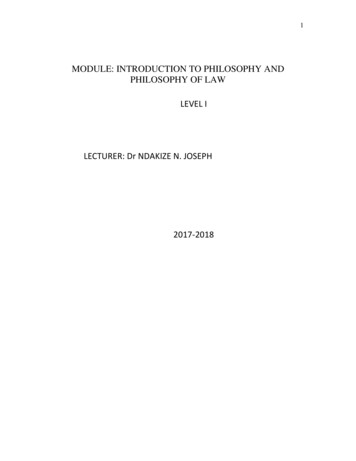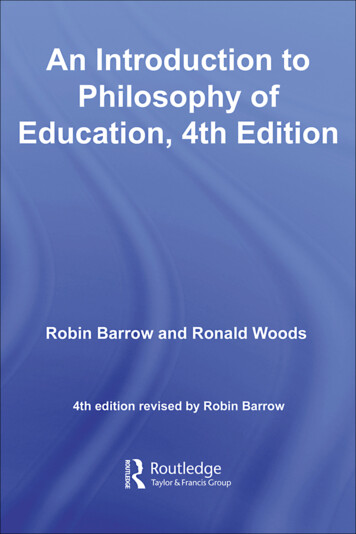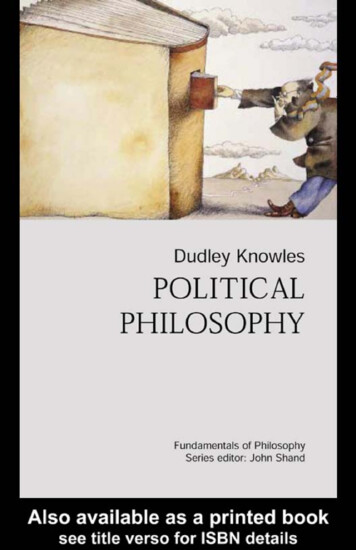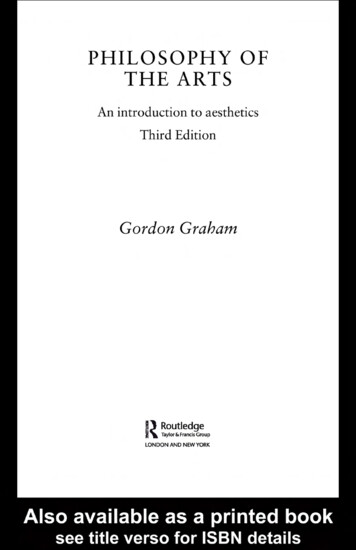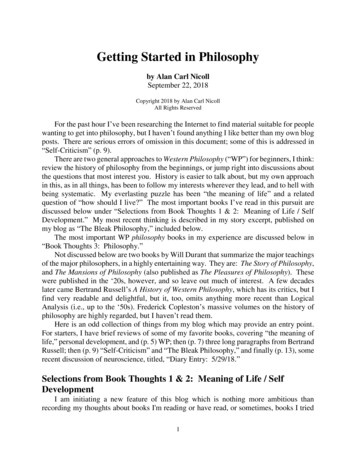
Transcription
INTRODUCTIONTO THE PHILOSOPHYOF SCIENCEA Text by Members of the Departmentof the History a n d Philosophy o f Scienceof the University o f PittsburghMerrilee H. Salmon- JohnEarmanJames G. Lennox Clark Glymour Peter MachamerJohn D. Norton Wesley C. Salmon J. E. McGuire Kenneth F. SchqffnerCopyright 1992 by Prentice-Hall, Inc.Hackett Publishing CompanyIndianapolis/Cambridge
To the giantsOn whose shoulders we standCopyright 1992 by Prentice-Hall, Inc.Reprinted 1999 by Hackett Publishing Company, Inc.All rights reservedPrinted in the United States of America05 04 03 02 01 00 9912 3 4 5 6 7 8 9For further information, please addressHackett Publishing Company, Inc.PO Box 44937Indianapolis, IN 46244-0937Library of Congress Cataloging-in-Publication DataIntroduction to the philosophy of science / Merrilee H. Salmon . . . [et al.].p.cm.Originally published: Englewood Cliffs, NJ. : Prentice Hall,c 1992.Includes bibliographical references and index.ISBN 0-8722O451-0 (cloth). — ISBN 0-87220-450-2 (paper)1. Science—Philosophy. I. Salmon, Merrilee H.Q175.I633 199998-48586501—dc21CIPThe paper used in this publication meets the minimum requirements of American National Standardfor Information Sciences—Permanence of Paper for Printed Library Materials, ANSI Z39.48-1984.
PART I. GENERAL TOPICS IN THE PHILOSOPHY OF SCIENCEOneSCIENTIFIC EXPLANATIONWesley C. SalmonThe fruits of science are many and various. When science is first mentioned, manypeople think immediately of high technology. Such items as computers, nuclear energy , genetic engineering, and high-temperature superconductors are likely to be included. These are the fruits of applied science. Evaluating the benefits, hazards, andcosts of such technological developments often leads to lively and impassioned debate.In this chapter, however, we are going to focus on a different aspect of science,namely, the intellectual understanding it gives us of the world we live in. This is thefruit of pure science, and it is one we highly prize. All of us frequently ask thequestion "Why?" in order to achieve some degree of understanding with regard tovarious phenomena. This seems to be an expression of a natural human curiosity.Why, during a total lunar eclipse, does the moon take on a coppery color instead ofjust becoming dark when the earth passes between it and the sun? Because the earth'satmosphere acts like a prism, diffracting the sunlight passing through it in such a waythat the light in the red region of the spectrum falls upon the lunar surface. This is arough sketch of a scientific explanation of that phenomenon, and it imparts at leastsome degree of scientific understanding.Our task in this chapter is to try to say with some precision just what scientificexplanation consists in. Before we embark on that enterprise, however, some preliminary points of clarification are in order.1.1 EXPLANATION VS. CONFIRMATIONThe first step in clarifying the notion of scientific explanation is to draw a sharpdistinction between explaining why a particular phenomenon occurs and giving rea7
sons for believing that it occurs. My reason for believing that the moon turns copperyduring total eclipse is that I have observed it with my own eyes. I can also appeal tothe testimony of other observers. That is how the proposition that the moon turnscoppery during a total eclipse is confirmed,1 and it is entirely different from explaining why it happens. Consider another example. According to contemporary cosmology all of the distant galaxies are receding from us at high velocities. The evidencefor this is the fact that the light from them is shifted toward the red end of thespectrum; such evidence confirms the statement that the other galaxies are movingaway from our galaxy (the Milky Way). The fact that there is such a red shift doesnot explain why the galaxies are moving in that way; instead, the fact that they arereceding explains—in terms of the Doppler effect2—why the light is shifted towardthe red end of the spectrum. The explanation of the recession lies in the "big bang"with which our universe began several billion years ago; this is what makes all of thegalaxies recede from one another and, consequently, makes all of the others moveaway from us.1.2 OTHER KINDS OF EXPLANATIONAnother preliminary step in clarifying the notion of scientific explanation is to recognize that there are many different kinds of explanation in addition to those weclassify as scientific. For example, we often encounter explanations of how to dosomething—how to use a new kitchen gadget, or how to find a certain address in astrange city. There are, in addition, explanations of what—what an unfamiliar wordmeans, or what is wrong with an automobile. While many, if not all, scientificexplanations can be requested by means of why-questions, requests for explanationsof these other sorts would not normally be phrased in why-questions; instead, howto-questions and wto-questions would be natural.Still other types of explanation exist. Someone might ask for an explanation ofthe meaning of a painting or a poem; such a request calls for an artistic interpretation.Or, someone might ask for an explanation of a mathematical proof; an appropriateresponse would be to fill in additional steps to show how one gets from one step toanother in the original demonstration. Neither of these qualifies as scientific explanation. Also excluded from our domain of scientific explanation are explanations offormal facts of pure mathematics, such as the infinitude of the set of prime numbers.We are concerned only with explanation in the empirical sciences.As we understand the concept of scientific explanation, such an explanation isan attempt to render understandable or intelligible some particular event (such as the1986 accident at the Chernobyl nuclear facility) or some general fact (such as thecopper color of the moon during total eclipse) by appealing to other particular and/orgeneral facts drawn from one or more branches of empirical science. This formulation1Confirmation will be treated in Chapter 2 of this book.The Doppler effect is the lengthening of waves emitted by a source traveling away from a receiver andthe shortening of waves emitted by a source approaching a receiver. This effect occurs in both light and sound,and it can be noticed in the change of pitch of a whistle of a passing train.28Scientific Explanation
is not meant as a definition, because such terms as "understandable" and "intelligible' ' are as much in need of clarification as is the term ' 'explanation.'' But it shouldserve as a rough indication of what we are driving at.In pointing out the distinction between scientific explanations and explanationsof other types we do not mean to disparage the others. The aim is only to emphasizethe fact that the word "explanation" is extremely broad—it applies to a great manydifferent things. We simply want to be clear on the type of explanation with which ourdiscussion is concerned.1.3 SCIENTIFIC EXPLANATIONS AND WHY-QUESTIONSMany scientific explanations are requested by means of why-questions, and evenwhen the request is not actually formulated in that way, it can often be translated intoa why-question. For example, "What caused the Chernobyl accident?" or "For whatreason did the Chernobyl accident occur?" are equivalent to "Why did the Chernobylaccident occur?" However, not all why-questions are requests for scientific explanations. A woman employee might ask why she received a smaller raise in salary thana male colleague when her job-performance is just as good as his. Such a whyquestion might be construed as a request for a justification, or, perhaps, simply arequest for more pay. A bereaved widow might ask why her husband died eventhough she fully understands the medical explanation. Such a why-question is arequest for consolation, not explanation. Some why-questions are requests for evidence. To the question, "Why should we believe that the distant galaxies are traveling away from us at high velocities?" the answer, briefly, is the red shift. Recall,as we noted in Section 1.1, that the red shift does not explain the recession. Therecession explains the red shift; the red shift is evidence for the recession. For the sakeof clarity we distinguish explanation-seeking why-questions from why-questions thatseek such other things as justification, consolation, or evidence.Can all types of scientific explanation be requested by why-questions? Someauthors say " y e s " and others say " n o . " It has been suggested, for example, thatsome scientific explanations are answers to how-possibly-questions. There is an oldsaying that a cat will always land on its feet (paws), no matter what position it fallsfrom. But remembering the law of conservation of angular momentum we might wellask, "How is it possible for a cat, released (without imparting any angular momentum) from a height of several feet above the ground with its legs pointing upward, toturn over so that its paws are beneath it when it lands? Is this just an unfounded beliefwith no basis in fact?'' The answer is that the cat can (and does) twist its body in waysthat enable it to turn over without ever having a total angular momentum other thanzero (see Frohlich 1980).Other requests for explanation may take a how-actually form. A simple commonsense example illustrates the point. "How did the prisoner escape?" calls for anexplanation of how he did it, not why he did it. The answer to this question might bethat he sawed through some metal bars with a hacksaw blade smuggled in by his wife.If we were to ask why, the answer might be his intense desire to be with his wifeoutside of the prison. For a somewhat more scientific example, consider the question,Scientific Explanation9
"How did large mammals get to New Zealand?" The answer is that they came inboats—the first were humans, and humans brought other large mammals. Or, consider the question, "How is genetic information transmitted from parents to offspring?" The answer to this question involves the structure of the DNA molecule andthe genetic code.In this chapter we will not try to argue one way or other on the issue of whetherall scientific explanations can appropriately be requested by means of why-questions.We will leave open the possibility that some explanations cannot suitably be requested by why-questions.1.4 SOME MATTERS OF TERMINOLOGYAs a further step in preliminary clarification we must establish some matters ofterminology. In the first place, any explanation consists of two parts, the explanandum and the explanans. The explanandum is the fact that is to be explained. This factmay be a particular fact, such as the explosion of the Challenger space-shuttlevehicle, or a general fact, such as the law of conservation of linear momentum. Astatement to the effect that the explanandum obtained is called the explanandumstatement. Sometimes, when it is important to contrast the fact-to-be-explained withthe statement of the explanandum, we may refer to the explanandum itself as theexplanandum-fact. When the explanandum is a particular fact we often speak of it asan event or occurrence, and there is no harm in this terminology, provided we areclear on one basic point. By and large, the events that happen in our world are highlycomplex, and we hardly ever try to explain every aspect of such an occurrence. Forexample, in explaining the explosion of the Challenger vehicle, we are not concernedto explain the fact that a woman was aboard, the fact that she was a teacher, or thefact that her life had been insured for a million dollars. When we speak of a particularfact, it is to be understood that this term refers to certain limited aspects of the eventin question, not to the event in its full richness and complexity.The other part of an explanation is the explanans. The explanans is that whichdoes the explaining. It consists of whatever facts, particular or general, are summoned to explain the explanandum. When we want to refer to the statements of thesefacts we may speak of the explanans-statements\ to contrast the facts with the statements of them we may also speak of the explanans-facts.In the philosophical literature on scientific explanation, the term "explanation"is used ambiguously. Most authors use it to apply to a linguistic entity composed ofthe explanans-statements and the explanandum-statement. Others use it to refer to thecollection of facts consisting of the explanans-facts and the explanandum-fact. Inmost contexts this ambiguity is harmless and does not lead to any confusion. But weshould be aware that it exists.1.5 DEDUCTION AND INDUCTIONAs we will see, one influential philosophical account of explanation regards all bonafide scientific explanations as arguments. An argument is simply a set of statements,10Scientific Explanation
one of which is singled out as the conclusion of the argument. The remaining members of the set are premises. There may be one or more premises; no fixed number ofpremises is required.3 The premises provide support for the conclusion.All logically correct arguments fall into two types, deductive and inductive, andthese types differ fundamentally from one another. For purposes of this chapter (andlater chapters as well) we need a reasonably precise characterization of them. Fourcharacteristics are important for our discussion.DEDUCTION1. In a valid deductive argument, all ofthe content of the conclusion is present,at least implicitly, in the premises. Deduction is nonampliative.2. If the premises are true, the conclusionmust be true. Valid deduction is necessarily truth-preserving.3. If new premises are added to a validdeductive argument (and none of theoriginal premises is changed or deleted)the argument remains valid. Deduction iserosion-proof.4. Deductive validity is an all-or-nothingmatter; validity does not come in degrees,An argument is totally valid or it is invalid.INDUCTION1. Induction is ampliative. The conclusion of an inductive argument has contentthat goes beyond the content of its premises.2. A correct inductive argument mayhave true premises and a false conclusion. Induction is not necessarily truthpreserving.3. New premises may completely undermine a strong inductive argument. Induction is not erosion-proof.4. Inductive arguments come in differentdegrees of strength. In some inductionsthe premises support the conclusionsmore strongly than in others.These characteristics can be illustrated by means of simple time-honored examples.(1)All humans are mortal.Socrates is human.Socrates is mortal.Argument (1) is obviously a valid deduction. When we have said that all humans aremortal, we have already said that Socrates is mortal, given that Socrates is human.Thus, it is nonampliative. Because it is nonampliative, it is necessarily truthpreserving. Since nothing is said by the conclusion that is not already stated by thepremises, what the conclusion says must be true if what the premises assert is true.Moreover, the argument remains nonampliative, and hence, necessarily truthpreserving, if new premises—for example, "Xantippe is human"—are added. Youcannot make a valid deduction invalid just by adding premises. Finally, the premises3Because of certain logical technicalities, there are valid deductive arguments that have no premises atall, but arguments of this sort will not be involved in our discussion.Scientific Explanation11
support the conclusion totally, not just to some degree; to accept the premises andreject the conclusion would be outright self-contradiction.(2)All observed ravens have been black.All ravens are black.This argument is obviously ampliative; the premise refers only to ravens that havebeen observed, while the conclusion makes a statement about all ravens, observed orunobserved. It is not necessarily truth-preserving. Quite possibly there is, was, or willbe—at some place or time—a white raven, or one of a different color. It is noterosion-proof; the observation of one non-black raven would undermine it completely. And its strength is a matter of degree. If only a few ravens in one limitedenvironment had been observed, the premise would not support the conclusion verystrongly; if vast numbers of ravens have been observed under a wide variety ofcircumstances, the support would be much stronger. But in neither case would theconclusion be necessitated by the premise.Deductive validity and inductive correctness do not hinge on the truth of thepremises or the conclusion of the argument. A valid deduction may have true premises and a true conclusion, one or more false premises and a false conclusion, andone or more false premises and a true conclusion. 4 When we say that valid deductionis necessarily truth-preserving, we mean that the conclusion would have to be true ifthe premises were true. Thus there cannot be a valid deduction with true premises anda false conclusion. Where correct inductive arguments are concerned, since they arenot necessarily truth-preserving, any combination of truth values of premises andconclusion is possible. What we would like to say is that, if the premises are true (andembody all relevant knowledge), the conclusion is probable. As we will see inChapter 2, however, many profound difficulties arise in attempting to support thisclaim about inductive arguments.We have chosen very simple—indeed, apparently trivial—examples in order toillustrate the basic concepts. In actual science, of course, the arguments are muchmore complex. Most of the deductive arguments found in serious scientific contextsare mathematical derivations, and these can be extremely complicated. Nevertheless,the basic fact remains that all of them fulfill the four characteristics listed above.Although deep and interesting problems arise in the philosophy of mathematics, theyare not our primary concern in this book. Our attention is focused on the empiricalsciences, which, as we argue in Chapter 2, necessarily involve induction. In thatchapter we encounter much more complex and interesting inductive arguments.1.6 IS THERE ANY SUCH THING AS SCIENTIFIC EXPLANATION?The idea that science can furnish explanations of various phenomena goes back toAristotle (4th century B.C.), and it has been reaffirmed by many philosophers and4The familiar slogan, "Garbage in, garbage out," does not accurately characterize deductive argu-ments.12Scientific Explanation
scientists since then. Nevertheless, many other philosophers and scientists have maintained that science must "stick to the facts," and consequently can answer onlyquestions about what but not about why. To understand "the why of things," theyfelt, it is necessary to appeal to theology or metaphysics. Science can describe naturalphenomena and predict future occurrences, but it cannot furnish explanations. Thisattitude was particularly prevalent in the early decades of the twentieth century. Sinceit is based upon certain misconceptions regarding scientific explanation, we need tosay a bit about it.It is natural enough, when attempting to find out why a person did something,to seek a conscious (or perhaps unconscious) motive. For example, to the question,"Why did you buy that book?" a satisfactory answer might run, "Because I wantedto read an amusing novel, and I have read several other novels by the same author,all of which I found amusing.'' This type of explanation is satisfying because we canput ourselves in the place of the subject and understand how such motivation works.The concept of understanding is critical in this context, for it signifies empathy. If weyearn for that kind of empathetic understanding of nonhuman phenomena, we have tolook elsewhere for motivation or purpose. One immediate suggestion is to make thesource of purpose supernatural. Thus, prior to Darwin, the variety of species of livingthings was explained by special creation—that is, God's will. Another manifestationof the same viewpoint—held by some, but not all, vitalists—was the notion thatbehind all living phenomena there is a vital force or entelechy directing what goes on.These entities—entelechies and vital forces—are not open to empirical investigation.The insistence that all aspects of nature be explained in human terms is knownas anthropomorphism. The supposition—common before the rise of modernscience—that the universe is a cozy little place, created for our benefit, with humansat its center, is an anthropomorphic conception. The doctrines of special creation andsome forms of vitalism are anthropomorphic. So-called "creation science" is anthropomorphic. Teleoiogical explanation of nonhuman phenomena in terms ofhuman-like purposes is anthropomorphic.5Many philosophers and scientists rejected the appeal to anthropomorphic andteleoiogical explanations as an appeal to hypotheses that could not, even in principle,be investigated by empirical science. If this is what is needed for explanation, theysaid, we want no part of it. Science is simply not concerned with explaining naturalphenomena; anyone who wants explanations will have to look for them outside ofscience. Such scientists and philosophers were eager to make clear that scientificknowledge does not rest on nonempirical metaphysical principles.Not all philosophers were willing to forgo the claim that science providesexplanations of natural phenomena. Karl R. Popper (1935), Carl G. Hempel (1948),R. B. Braithwaite (1953), and Ernest Nagel (1961) published important works inwhich they maintained that there are such things as legitimate scientific explanations,and that such explanations can be provided without going beyond the bounds ofempirical science. They attempted to provide precise characterizations of scientific5As James Lennox points out in Chapter 7, teleoiogical explanations are anthropomorphic only if theyappeal to human-like purposes. In evolutionary biology—and other scientific domains as well—there areteleoiogical explanations that are not anthropomorphic.Scientific Explanation13
explanation, and they were, to a very large degree, in agreement with respect to thecore of the account. The line of thought they pursued grew into a theory that enjoyeda great deal of acceptance among philosophers of science. We will discuss it at lengthin later sections of this chapter.1.7 DOES EXPLANATION INVOLVE REDUCTION TO THEFAMILIAR?It has sometimes been asserted that explanation consists in reducing the mysterious orunfamiliar to that which is familiar. Before Newton, for example, comets wereregarded as mysterious and fearsome objects. Even among educated people, theappearance of a comet signified impending disaster, for example, earthquakes, floods,famines, or epidemic diseases. Newton showed that comets could be understood asplanet-like objects that travel around the sun in highly eccentric orbits. For thatreason, any given comet spends most of its time far from the sun and well beyond therange of human observation. When one appeared it was a surprise. But when welearned that they behave very much as the familiar planets do, their behavior wasexplained, and they were no longer objects of dread.Appealing as the notion of reduction of the unfamiliar to the familiar may be,it is not a satisfactory characterization of scientific explanation. The point can best bemade in terms of a famous puzzle known as Olbers's paradox—which is named aftera nineteenth-century astronomer but was actually formulated by Edmund Halley in1720—why is the sky dark at night? Nothing could be more familiar than the darknessof the night sky. But Halley and later astronomers realized that, if Newton's conception of the universe were correct, then the whole night sky should shine as brightlyas the noonday sun. The question of how to explain the darkness of the sky at nightis extremely difficult, and there may be no answer generally accepted by the experts.Among the serious explanations that have been offered, however, appeal is made tosuch esoteric facts as the non-Euclidean character of space or the mean free path ofphotons in space. In this case, and in many others as well, a familiar phenomenon isexplained by reference to facts that are very unfamiliar indeed.I suspect that a deep connection exists between the anthropomorphic conceptionof explanation and the thesis that explanation consists in reduction of the unfamiliarto the familiar. The type of explanation with which we are best acquainted is that inwhich human action is explained in terms of conscious purposes. If it is possible toexplain the phenomena of physics or biology in terms of attempting to realize a goal,that is a striking case of reduction to the familiar. A problem with this approach is,of course, that a great deal of the progress in scientific understanding has resulted inthe elimination, not the injection, of purposes.1.8 THE DEDUCTIVE-NOMOLOGICAL PATTERN OF SCIENTIFICEXPLANATIONIn a classic 1948 paper, Carl G. Hempel and Paul Oppenheim formulated, with greatprecision, one pattern of scientific explanation that is central to all discussions of thesubject. It is known as the deductive-nomological (D-N) model of scientific explana14Scientific Explanation
tion. Stated very simply, an explanation of this type explains by subsuming itsexplanandum-fact under a general law. This can best be appreciated by looking at anexample.A figure skater with arms outstretched stands balanced on one skate. Propellingherself with her other skate she begins to rotate slowly. She stops propelling herself,but she continues to rotate slowly for a few moments. Suddenly—without propellingherself again and without being propelled by any external object, such as anotherskater—she begins spinning very rapidly. Why? Because she drew her arms in closeto her body, thus concentrating her total body mass closer to the axis of rotation.Because of the law of conservation of angular momentum, her rate of rotation had toincrease to compensate for her more compact body configuration.More technically, the angular momentum of an object is the product of itsangular velocity (rate of rotation) and its moment of inertia. The moment of inertiadepends upon the mass of the object and the average distance of the mass from theaxis of rotation; for a fixed mass, the moment of inertia is smaller the more compactlythe mass is distributed about the axis of rotation. The law of conservation of angularmomentum says that the angular momentum of a body that is not being propelled orretarded by external forces does not change; hence, since the moment of inertia isdecreased, the rate of rotation must increase to keep the value of the product constant.6According to Hempel and Oppenheim, an explanation of the foregoing sort is tobe viewed as a deductive argument. It can be set out more formally as follows:(3)The angular momentum of any body (whose rate of rotation is not being increased or decreased by external forces) remains constant.The skater is not interacting with any external object in such a way as to alter her angularvelocity.The skater is rotating (her angular momentum is not zero).The skater reduces her moment of inertia by drawing her arms in close to her body.The skater's rate of rotation increases.The explanandum—the increase in the skater's rate of rotation—is the conclusion ofthe argument. The premises of the argument constitute the explanans. The firstpremise states a law of nature—the law of conservation of angular momentum. Theremaining three premises state the antecedent conditions. The argument is logicallycorrect; the conclusion follows validly from the premises. For purposes of our discussion, we may take the statements of antecedent conditions as true; expert figureskaters do this maneuver frequently. The law of conservation of angular momentumcan also be regarded as true since it is a fundamental law of physics which has beenconfirmed by a vast quantity of empirical data.Hempel and Oppenheim set forth four conditions of adequacy for D-N explanations:6In this example we may ignore the friction of the skate on the ice, and the friction of the skater's bodyin the surrounding air.Scientific Explanation15
1. The explanandum must be a logical consequence of the explanans; that is, theexplanation must be a valid deductive argument.2. The explanans must contain at least one general law, and it must actually berequired for the derivation of the explanandum; in other words, if the law orlaws were deleted, without adding any new premises, the argument would nolonger be valid.3. The explanans must have empirical content; it must be capable, at least inprinciple, of test by experiment or observation.4. The sentences constituting the explanans must be true.These conditions are evidently fulfilled by our example. The first three are classifiedas logical conditions of adequacy; the fourth is empirical. An argument that fulfills allfour conditions is an explanation (for emphasis we sometimes say ''true explanation"). An argument that fulfills the first three conditions, without necessarily fulfilling the fourth, is called a potential explanation. It is an argument that would be anexplanation if its premises were true.7According to Hempel and Oppenheim, it is possible to have D-N explanations,not only of particular occurrences as in argument (3), but also of general laws. Forexample, in the context of Newtonian mechanics, it is possible to set up the followingargument:(4) F ma (Newton's second law).For every action there is an equal and opposite reaction (Newton's third law).In every interaction, the total linear momentum of the system of interacting bodies remainsconstant (law of conservation of linear momentum).This argument is valid, and among its premises are statements of general laws. Thereare no statements of antecedent conditions, but that is not a problem since theconditions of adequacy do not require them. Because we are not concerned to explainany particular facts, no p
INTRODUCTION TO THE PHILOSOPHY OF SCIENCE A Text by Members of the Department of the History a n d Philosophy o f Science of the University o f Pittsburgh Merrilee H. Salmon- JohnEarman Clark Glymour James G. Lennox Peter Machamer J. E. McGuire

